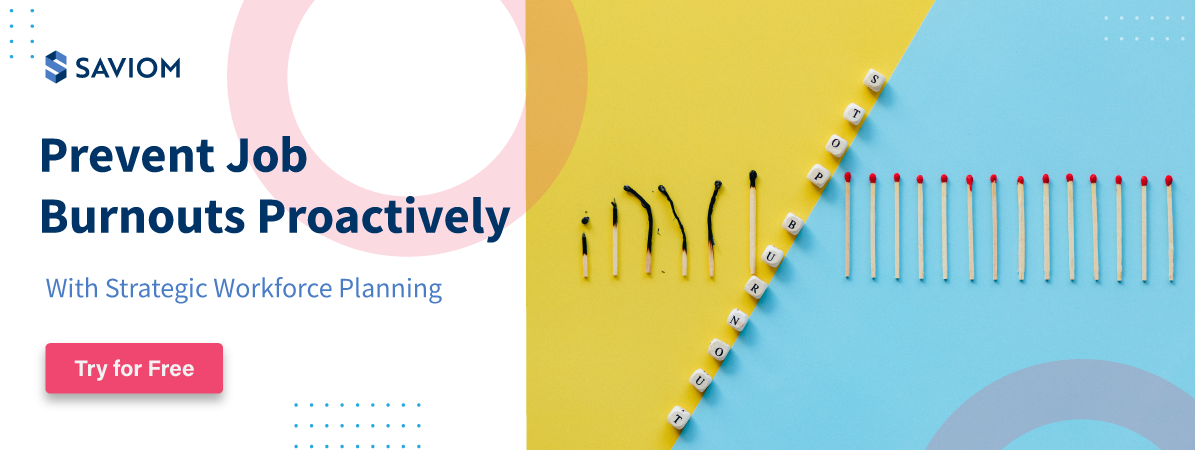No one is a stranger to work pressure. When it’s under control, pressure helps you stay disciplined. Unfortunately, pressure isn’t something that’s served in moderation. The tendency to equate self-worth to the ability to surpass expectations results in employee burnout.
Employee burnout is a psychological phenomenon that is thought to result from physical and mental exhaustion. Ever since the COVID outbreak in 2020, remote work has been on the rise. And with it, an alarming 33% rise in employee burnout signs. This is attributed to the fact that work norms have been overhauled. People are expected to be available, online and alert at all times, now that they have nowhere else to be but home.
In 2018, 23% of the 7500 employees Gallup surveyed experienced burnout.
Such employees also faced challenges discussing performance goals with their manager.
We have a long way to go before declaring any workplace to be completely devoid of employee burnout, but we can certainly start somewhere. And what better way than to see where workforce planning fits into all of this?
What is Employee Burnout?
According to the Mayo Clinic, employee burnout is a type of work-related stress that impacts mental, emotional and physical health. It is more likely to affect people suffering from depression.
Employee burnout has more to do with how people are managed than setting standards for performance. Mismanaged employees end up feeling stressed and fatigued, more so when expectations grow but deadlines get shorter. Consequently, their performance dips. Individuals on the verge of a burnout feel a loss of identity and a reduced sense of achievement.
The Reasons for employees burnout
Possible causes of employee burnout include
Lack of control
This depends on the seniority of the employee. Generally speaking, interns and graduates are always closely supervised and are given instructions and guidance until they gain mastery over their role. But you can’t apply the same rule to older employees. Not giving them some autonomy to decide what gets done can make them feel that they’re no longer in control of their schedule, bandwidth and assignments.
Work overload
This happens when everything is a priority. Conflicts ensue, and the schedule gets overloaded. The only way to get things done is to work overtime and put in extra effort hours.
Unclear expectations
Anxiety sets in when expectations keep changing, or are ambiguous right from the outset.
Dysfunctional dynamics
Managers who use bullying tactics or micromanage end up with employees who are stressed and resentful. Such employees gradually lose interest in both work and interacting with their team manager.
Process inefficiencies
Relying on old processes for new lines of work can create gaps. Even a lack of the right aid you need for your work can burn you out.
Peer pressure
Peer pressure causes employees to push themselves to meet impossible standards. And when they fail, they become hard on themselves and live in fear that their appraisals will be adversely impacted.
Lack of, or insufficient support
A support system is essential to keeping motivation levels high. The absence of it either at work or on the personal front can make you feel isolated and alienated, contributing to higher stress levels.
In short, burnout can affect anyone under the wrong circumstances. And when it hits, it affects productivity, health and morale.
Bias
Bias at work is one of the factors behind workplace toxicity. In the absence of impartial assessment metrics, bias impacts teams at an individual and group level. Employees who see favoritism are more likely to experience burnout because of the feeling that their contributions and efforts are undervalued.
If your company is guilty of any or all of the above, don’t stop reading. There’s something you should know about unchecked employee burnout in order to combat it.
Personal issues
Issues on the personal front can weigh heavily on an employee’s mind no matter how much they try to brush it off. The trouble with this going unaddressed is that it’ll come to a point where even a simple task will seem difficult. The truth is, not being able to do both work and personal commitments justice can make employees feel like they’re compromising. And most times, on the wrong thing. Many organizations have in-house psychologists and counselors to provide support in such a situation. Having an impartial party listen can help you see the problem more clearly. Managers can also work with the employee to scale back or adjust priorities accordingly.
Alcohol Addiction and substance abuse
We all have our vices, but overworked employees are at risk of using it as a coping mechanism or energy booster. Over time, this develops into an addiction to prohibitive substances, which adversely impact employee performance.

The Adverse effects of unchecked employee burnout
Compromised work quality
Work quality goes down when your once-top performing employees are too stressed,exhausted and overworked to maintain their performance. This is more so when employees have to multitask to demonstrate their commitment to completing requests that they get from different managers or colleagues.
Ultimately, they’re unable to do any single task full justice and end up doing “shallow work”. Shallow work is a term coined by celebrated author and Professor Cal Newport of Georgetown University. He defines it as performing non-cognitive work in a distracted state of mind. The work may fill up your day, but contributes little to achieving objectives.
Disinterest
Employees who are on the brink of burning out lose interest in work. This is because they associate it with their elevated stress levels and instinctively distance themselves from the source of pressure. If the disinterest grows, such employees may also seek out opportunities elsewhere. They may not cooperate during knowledge transfers and handovers.
Suboptimal performance
Once the burnout feeling sinks in, it’s difficult for employees to get back on track without professional help. If communication barriers exist, employees would refrain from discussing what they’re going through. This reflects in their performance and inability to meet goals that they were previously able to reach.
Absence of goodwill
So it has come to your attention that some employees are exhibiting the classic signs of employee burnout. But you’re not doing anything about it, either because
A) it hasn’t yet impacted financial and operational performance or B)you are unsure of how to address it.
The trouble with this is that the longer you sleep on it, the more likely you’re going to lose employees. And if you’re not intentional about cultivating and maintaining employee goodwill, you may be the subject of negative reviews on job search sites which will affect how prospective applicants look at you as an employer.
High employee turnover
A high employee turnover indicates a business environment that is high-pressured and unstable. When employees are treated as dispensable entities, it not only impacts current employees but also causes prospective applicants to rethink applying for vacancies. will think twice because a history of hiring, firing and rehiring may take longer to find.
Loss of business credibility and customer satisfaction
Depending on the nature of work, burnout can take a toll on the mental and physical health of an employee. Those employees who are habitually stressed out will not be capable of performing at their optimum best when their energy levels and enthusiasm are drooping. And these are cues clients can pick up on, especially when the employee makes promises they can’t keep. The business starts to lose its credibility when other customers notice how it’s falling behind on deadlines and commitments.
What is Workforce Planning?
Workforce planning is the process of assessing organizational needs from the viewpoint of its resource pool. Enterprise workforce planning solutions help businesses determine short-term, mid-term and long-term requirements for the type and number of skills.
Project managers work closely with workforce planning managers. Departments or business units within a company place skills requests. These requests goto workforce managers who scan a workforce planning software to find, onboard, allocate, optimize and forecast resources. Strategic workforce planning helps employers staff billable and non-billable work with the right knowledge and expertise so that work can stay on course.
Workforce planning is used to study hiring requirements and plan out the recruiting of new people, even the order in which the roles advertised are to be filled.
Ways in which workforce planning prevents employee burnout
Workforce planning can not only help you tap into your existing resource pool’s potential but can also economize it with the right resources at all times. Here are a few ways workforce planning can prevent employee burnout;
Optimizes workloads
Visibility at an enterprise-level lets managers see those scheduled activities that are completed, as well as which ones should be scheduled. If there is an imbalance in terms of an under or overload, team leads can take corrective action to optimize. They can make use of resource utilization graphs to know if the capacity’s bandwidth can be released or reassigned to priority tasks. When everyone is assigned work in line with their expertise, area of interest, knowledge, and availability, they can remain productive.
Conducts status checks:
Managers can use the workforce planner’s Gantt style drag-and drop interface to create bookings. They can assign resources onto projects and split or divide bookings across the schedule. The tool even sends out early warnings in the event of an overload, which prevents you from creating an unreasonable load.
Generates a unified scale for Performance Measurement
Besides availability reports, workforce planning software contains a capacity versus demand that computes the work hours available in line with demand hours. Converting effort estimates into a unified scale lets managers allocate work according to the type of resource, skills required to be released and the percentage or number of hours it will be required.
All resource types are brought to a single central scale, which prevents bias.
Prioritizes Work
The first step to optimizing your workforce’s workload is to recognize that everything cannot be a priority. Doing so results in team members reaching fewer milestones. In such circumstances, they’ll take longer to deliver the deliverables agreed upon despite pulling weeknighters and putting in overtime.
The goal is to staff meaningful work over non-billable activities and function so that projects offering high returns are not sidetracked. Prioritizing helps employees reach milestones without overrunning project constraints.
Enables growth at-scale
Workforce planning’s forecasting facility predicts future capacity for demand and lets managers estimate bandwidth ahead of confirmed projects. Any existing skill gaps can be bridged with appropriate skilling measures. You can even calculate a more accurate lead time that factors in the time to advertise, hire, onboard and train new resources based on the insights the tool offers.
Additionally, running What-If scenarios helps you analyze where and when you’ll face a resource crunch, and even the type of resource you’ll need down the line. This ghost resource is a placeholder for the kind of skills you need for the project and location in question.
Creates a skills matrix
A competency database or skills matrix contains a list of all skills and certifications, and the departments and locations they are in. It makes it easy for resource managers to match requests to relevant and available skills. What’s more, resources can avail the open seat facility to explore a project that’s of interest to them. It’s a win-win for everyone!
Finalizes deadlines based on feasibility
Managers can assess the project’s feasibility in terms of complexity of tasks and subtasks, dependencies, constraints, risks and returns before feeding it into the pipeline. This helps businesses costs by picking only those projects that align with business goals. Your resource pool too will not have to be assigned to work that’s not helping them grow professionally nor making use of their competence.
Facilitates operational compliance
Operational excellence teams are internal auditors who can independently review resource, financial and operational performance. This body sets the precedent for governance and determines if there are process inefficiencies that have resulted from work overloads.
The insights from workforce planning software, combined with feedback from exit interviews play a role in helping businesses improve workplace practices.
Helps managers reward high-utilization
Resource utilization reports within a workforce planning tool can help managers assess the distribution of utilization by resource, department, team, and project. This insight can identify those employees whose utilization rates are consistently optimal and high. Such employees can be encouraged to avail complimentary offs or in-house skills building in an area that interests them.
Prevents competing interests
Some project managers are reluctant to release a good resource from a project even when they know there are other projects that can tap into their potential. As a result, there’s a skills crunch with managers competing for the same resource at the same time. The staff themselves get caught up in the tug of war and end up doing jobs that aren’t interesting to them. Loss of interest can cause burn out.
Organizations can out rotate a resource from a project after a certain time period. And track this across activities using a Workforce planning software.
The Bottomline
No matter how your team composition shifts, contracts or expands, the goal is to ensure your organization doesn’t lose high performers to employee burnouts and workplace stress. There’s no time like the present to fix the future, and that’s exactly what Workforce planning does. It contextualizes work around employee productivity, thus becoming the key to acquiring, engaging and retaining the best resources.
After all, it’s not enough that you’ve hired the right people. They should also feel engaged, recognized and appreciated. This way, they are less likely to burn out. In fact, you are doing employees and your business a favor by equipping them with the tools and support to succeed.















